
 |
|
|
#1 |
|
Member
Join Date: Mar 2006
Location: Room 101, Glos. UK
Posts: 4,259
|
just managed to snag my first real kris on ebay, it's coming from the states in 6-10 days supposedly. more pics after arrival.
Linky     looks a bit like someone stuck it in the scabbard wrong way round 
|
|
|

|
|
|
#2 |
|
Member
Join Date: Jan 2006
Location: Kent
Posts: 2,658
|
Nice One......at a very nice price
 Congrats Kronckew .... I like these but haven't seen one at the 'right' price. Would be interested in the experts opinions. Congrats Kronckew .... I like these but haven't seen one at the 'right' price. Would be interested in the experts opinions.Happy New Year to you all.  Regards David |
|
|

|
|
|
#3 |
|
Member
Join Date: Dec 2004
Location: Greenville, NC
Posts: 1,854
|
This is a mid 20th century kriss, and a nice example of such.
|
|
|

|
|
|
#4 |
|
Member
Join Date: Mar 2006
Location: Room 101, Glos. UK
Posts: 4,259
|
hi charles,
i had noted the integral ganya and the grip appears nicely newly wrapped & unworn, so i'd assumed it was not an early one, but it does have a few decades on it by appearances, so i'm glad to get the confirmation. |
|
|

|
|
|
#5 |
|
EAAF Staff
Join Date: Dec 2004
Location: Louisville, KY
Posts: 7,350
|
Not sure if this is what you are talking about but the part where the blade sticks out was broken off and recarved.
Oh yeah, I know Charles loves to hear this - Charles is right, 20th century. |
|
|

|
|
|
#6 |
|
Member
Join Date: Dec 2004
Location: Kernersville, NC, USA
Posts: 793
|
Oh, it's a slippery slope you're going down now.
 Like other pieces, kris are addictive. Like other pieces, kris are addictive.Nice first kris. Looks very much like my first one. Good start! Steve |
|
|

|
|
|
#7 |
|
Member
Join Date: Mar 2006
Location: Room 101, Glos. UK
Posts: 4,259
|
moro kris arrived today, i am quite pleased with it, grip is tight, complete and undamaged except for a couple small pieces of MOP inlay that have been chipped. blade is sharp, had a few black rust spots but nothing active. needed a bit of a clean to get some white metal polish residue off the copper baca-bacas and the gangya nooks and crannies. ran a steel along the edges to clean off a couple small rust spots, the blade 'sings' when its stroked
 it has now been oiled with scented mineral oil . it has now been oiled with scented mineral oil .i see that the ebay pics have disappeared, so here are some more.   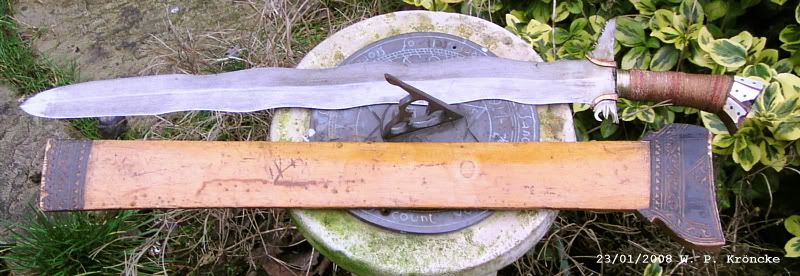 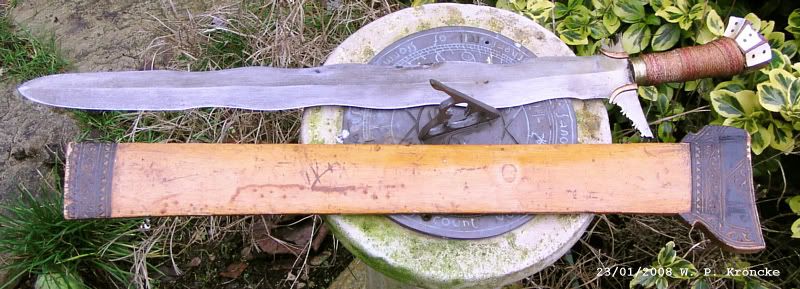 not shown, the pommel end had two triangular pieces of MOP inlayed either side of a decorative carved transverse groove. the scabbard is fancy carved on the port side of the scabbard, and not carved at all on the starboard side. the upper corner has in some past trauma had part of the wood knocked off and that has been smoothed and blackened, leaving the upper protrusion of the gangya exposed. if the scabbard is worn left side to show the carvings, the grip points to the rear and the scabbard must be twisted 90 degrees clockwise in order to grip correctly for a quick draw/strike iado fashion. if the owner was a lefty, and wore it on the right, it would be correct for a european style cross draw. Last edited by kronckew; 23rd January 2008 at 03:50 PM. |
|
|

|
|
|
#8 |
|
Member
Join Date: Mar 2006
Location: Room 101, Glos. UK
Posts: 4,259
|
some more photos of the gangya, scabbard mouth and grip, pommel end.
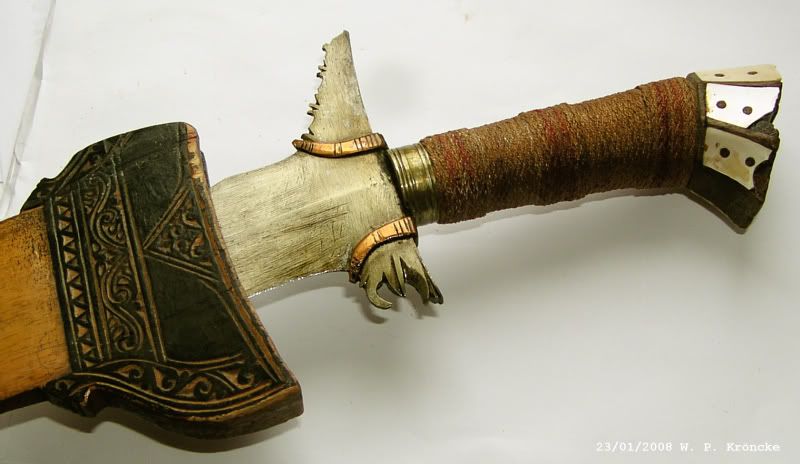 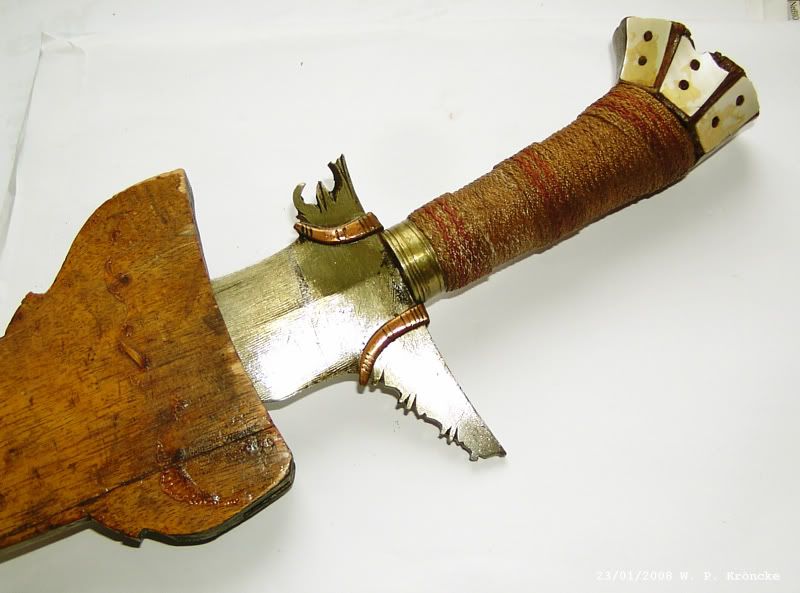 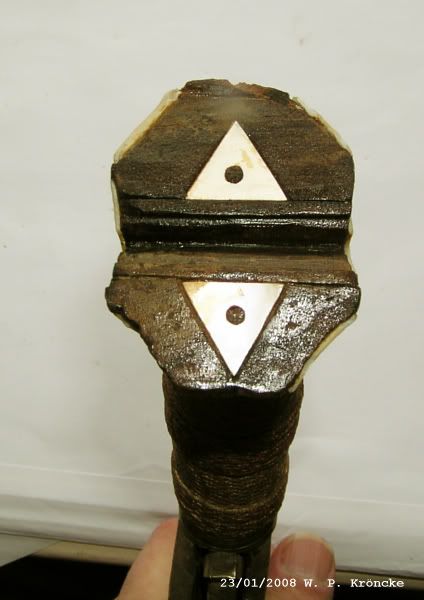 i really like this sword... 
|
|
|

|
|
|
#9 |
|
Vikingsword Staff
Join Date: Nov 2004
Posts: 6,378
|
Wearing the Kris .

|
|
|

|
|
|
#10 |
|
Member
Join Date: Mar 2006
Location: Room 101, Glos. UK
Posts: 4,259
|
thanks for that, makes a bit more sense of the carry. the only other clear picture i've found was a datu with a fancy ivory hilted kris which looked like it was in the sash with the longer portion of the gangya facing to the rear which is the opposite of the one in your pic & opposite to how mine appears. tribal differences?

|
|
|

|
|
|
#11 |
|
EAAF Staff
Join Date: Dec 2004
Location: Louisville, KY
Posts: 7,350
|
I think one is for show wear (datus) and the other is for fighting.
|
|
|

|
|
|
#12 |
|
Member
Join Date: Mar 2006
Location: Room 101, Glos. UK
Posts: 4,259
|
i found another one with the same placement
 good, i'd rather have a battle one than a show one anyway. that datu one above with the fancy ivory looks rather fragile. |
|
|

|
|
|
#13 |
|
EAAF Staff
Join Date: Dec 2004
Location: Louisville, KY
Posts: 7,350
|
Only because he is old and probably survived many battles. It could also be a certain type of kris. I have never seen the cockatua hilted ones looking backward, only forward, and some were battle pieces.
|
|
|

|
|
|
#14 |
|
Member
Join Date: Mar 2006
Location: Room 101, Glos. UK
Posts: 4,259
|
 i meant the hilt looked fragile, not the datu, he looks like he's not someone we'd like to mess with. i'd believe the krag and the ivory hilted .38 were his war souvenirs.... i meant the hilt looked fragile, not the datu, he looks like he's not someone we'd like to mess with. i'd believe the krag and the ivory hilted .38 were his war souvenirs....in university my fencing instructor was a little old 70 year old man about 5 ft 2in. tall and maybe 120 pounds. he was also the toughest person i've seen. he was also an ex hungarian army colonel and i gather he was a national sabre champion back in the thirties...you did not mess with him, he was always two steps ahead of you. |
|
|

|
|
|
#15 |
|
EAAF Staff
Join Date: Dec 2004
Location: Louisville, KY
Posts: 7,350
|
OH.......boy did I misunderstand....
 ... ...Yes that hilt is a little more fragile since it is ceremonial. His battle kris would not sport such a large ivory head. They always had several kris, at least one for ceremonial purposes and one for combat. My Filipino grandfather sounds like he would be at home with those folk upon which you spoke. He was a tough "old bird" and an escrimador as well as being a retired cop. |
|
|

|
|
|
#16 |
|
Member
Join Date: Mar 2005
Posts: 589
|
Hi All,
Could the difference in carry styles be the result of Japanese influence? The two older photos look to be pre WWII while the newer photo looks like it could be post WWII. If that's true, the iado draw style (along with the necessary sheath carry change) could have been picked up from the Japanese invaders. Sincerely, RobT |
|
|

|
|
|
#17 |
|
EAAF Staff
Join Date: Dec 2004
Location: Louisville, KY
Posts: 7,350
|
Not a bad idea except that the second old photo has the kris facing "backwards" like the one in the new photo.
|
|
|

|
|
|
#18 |
|
Member
Join Date: Apr 2005
Posts: 3,255
|
The edge-up carry mode (most are single-edged swords) is also pretty common throughout the Southeast Asian archipelagos.
The vast majority of early Moro pics also shows this orientation which is also confirmed by scabbard decorations or the carry notch on Maguindanao style scabbards. Regards, Kai |
|
|

|
|
|
#19 |
|
(deceased)
Join Date: Dec 2004
Location: OKLAHOMA, USA
Posts: 3,138
|
AS MOST PICTURES YOU SEE ARE POSED IT MAY BE THEY SOMETIMES CARRY THEIR KRIS AND OTHER WEAPONS DIFFERENT DUE TO THE REGUEST OF THE PHOTOGRAPHER'S VIEW OF HOW TO MAKE A GOOD PHOTO.
THE OLD WARRIOR HAS TWO BANDOLERS AND A KRIS THAT WOULD PROBABLY NOT BE HIS FIRST CHOICE FOR ACTUAL BATTLE EVEN IF IT IS HIS MOST CHERISHED POSSESION AND AN INDICATION OF HIS STATUS AS A WARRIOR AND DATU. WITH SO MUCH EQUIPMENT AND SUCH A LARGE IVORY POMMEL ADJUSTMENTS WOULD HAVE TO BE MADE AND THE PHOTOGRAPHER WOULD LIKE EVERYTHING TO SHOW IN THE PICTURE AND THE OLD DATU WOULD SURELY WANT HIS BEST KRIS IN THE PICTURE. OF COURSE A DATU WITH A RIFLE COULD STAY BACK AND SHOOT THE ENEMY WHILE HIS MEN ENGAGED THE ENEMY AT CLOSE QUARTERS SO HE COULD TAKE HIS DATU KRIS IF HE WANTED. IN THE OLD DAYS THERE WOULD HAVE BEEN NO FIREARMS JUST A SHIELD, SPEAR AND SWORD OF SOME FORM AND THE WARRIORS WHO HAD NOT YET CAPTURED OR TRADED FOR A FIREARM WERE PROBABLY STILL ARMED IN THE OLD WAY EVEN AGAINST FIREARMS. NEAT PICTURES  AND CONGRADULATIONS ON YOUR FIRST KRIS. AND CONGRADULATIONS ON YOUR FIRST KRIS.
|
|
|

|
|
|
#20 |
|
Member
Join Date: Mar 2005
Posts: 589
|
Hi Battara,
Well, that certainly shoots that theory all to heck. I made an assumption based on an incorrect interpretation of the replies and you know what happens when you assume instead of observing and considering carefully. Sincerely, RobT |
|
|

|
|
|
#21 |
|
EAAF Staff
Join Date: Dec 2004
Location: Louisville, KY
Posts: 7,350
|
That's ok - I have often made an asset of my self many, many times.
 Actually Robert it was not a bad idea..... |
|
|

|
|
|
#22 |
|
Member
Join Date: Mar 2006
Location: Room 101, Glos. UK
Posts: 4,259
|
one last question i have needs ellucidation.
when reading frederico's excellent info linked to on the reference site, i noted that during construction the kris blade would be descaled and shaped using a draw knife, with more recent ones being filed. how does one tell? my kris has a series of fine straight parallel grooves running longitudinally along the blade with no sign of what i would consider filing marks perpendicular to the edge, in fact i do not see any sign that the edge was ground to sharpen it other than a very fine polished edge bevel of maybe a millimeter & the lines are constant and parallel to the longitudinal axis right to the edge (there is some variation near the luks). i see no signs that a stone or grinder has ever been anywhere near this blade, no random marks as i'd expect from stoning or sanding/grinding. it certainly looks to my mechanical engineers eyes like it was scraped with a tool lengthwise rather than filed. the lines over most of the blade are very fine, but near the hilt are a bit more distinct. across the gangya itself they ARE perpendicular & across the blade from the ends of the baca-baca to the hilt. is this filed or drawn? what dates were the transition to filing or is that too broad? |
|
|

|
|
|
#23 |
|
EAAF Staff
Join Date: Dec 2004
Location: Louisville, KY
Posts: 7,350
|
Would you please post pictures - this would help tremendously.
|
|
|

|
|
|
#24 |
|
Member
Join Date: Mar 2006
Location: Room 101, Glos. UK
Posts: 4,259
|
OK, you can see the striations in this shot
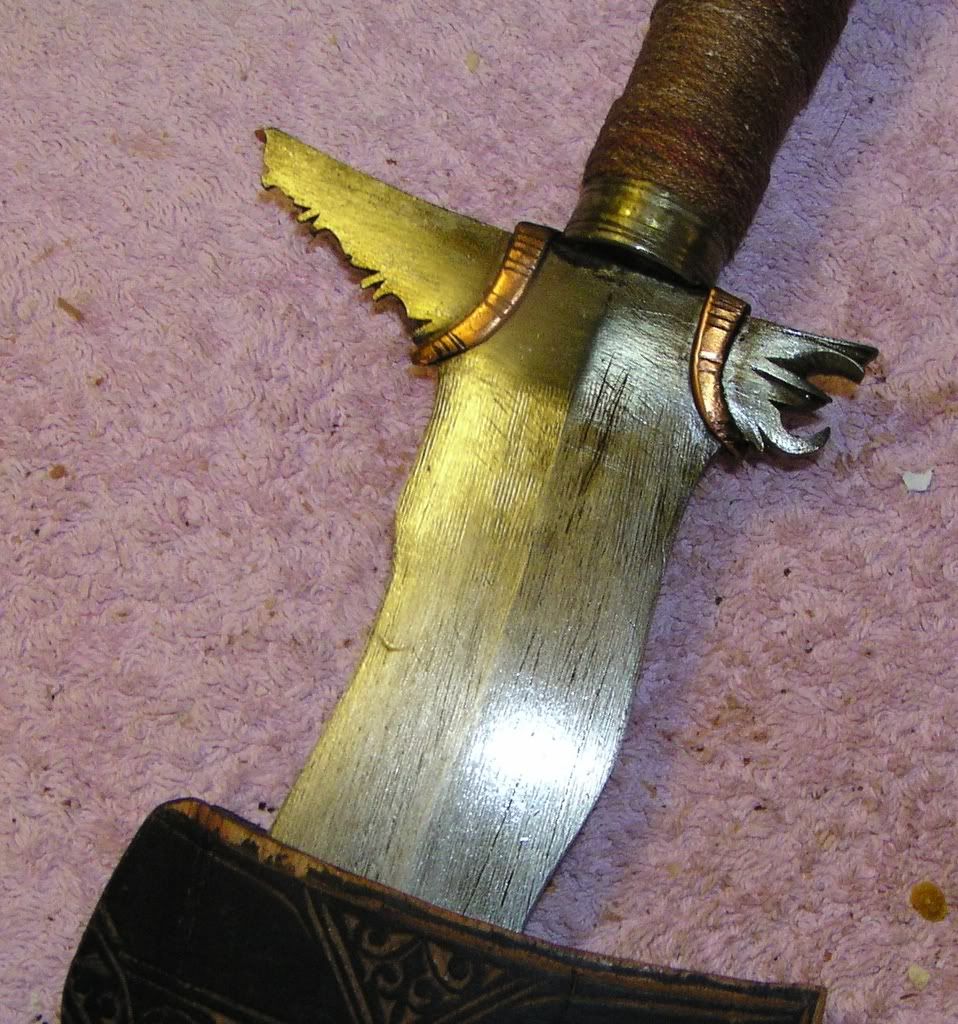 you can kind of see them in the earlier photos, but i've set the lighting on this one to exaggerate them a bit . |
|
|

|
|
|
#25 |
|
Member
Join Date: Apr 2005
Posts: 3,255
|
Hm, I'm not sure what caused these but IMHO it screams power tools (seems like this was done after the hilt and clamps were already fitted - maybe just a really bad cleaning/polishing job?). It certainly isn't something I've ever seen with an antique Moro kris.
Your blade has been grinded into shape (luk and gangya features formed by stock removal). In the traditional approach a blade would be forged into shape and would only need minor work to remove scale and to smooth the surface. Detailed work at the base of the blade would be done by specialized tools (including small files, I suppose) and then the blade would be ready for the final polishing steps. Regards, Kai |
|
|

|
|
|
#26 |
|
EAAF Staff
Join Date: Dec 2004
Location: Louisville, KY
Posts: 7,350
|
I'm with Kai on this one. You see more of this on mid - present made pieces.
|
|
|

|
 |
|
|